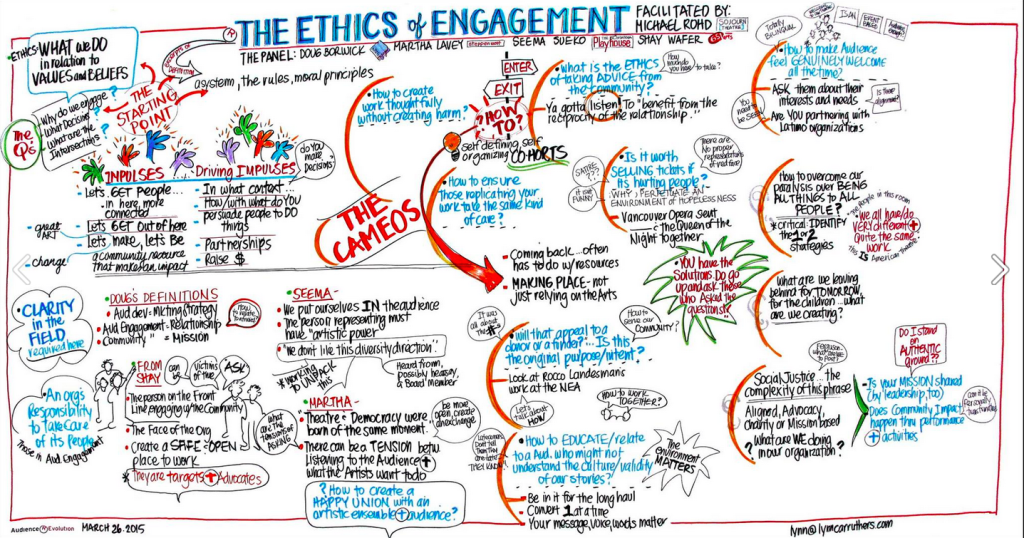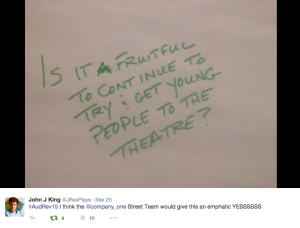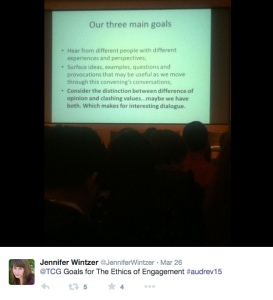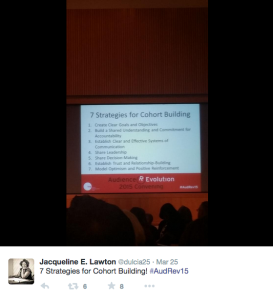available for purchase
at this time.
#StaffChat: TCG’s Audience (R)Evolution Convening
March 28, 2015
#StaffChat posts feature articles and news that the C1 team discusses as part of our weekly all-staff meeting. We’d love to hear your thoughts too — hit us up on Facebook or Twitter!
♦♦♦♦♦
This past week, the Theatre Communication Group — a membership organization for professional theatres in the US —hosted a convening as part of their Audience (R)Evolutions series:
Audience (R)Evolution is a multi-year program designed by TCG and funded the Doris Duke Charitable Foundation to study, promote and support successful audience engagement models across the country. This new initiative encompasses four phases unfolding over three years: research and assessment; convenings; grant-making; and widespread dissemination of audience engagement models that work.
200 theatre professionals, including Company One’s own Sarah Shampnois and John J King, met from March 25-27 in Kansas City to discuss best practices and new models for building bridges between the work on our stages and the work out in our communities. A full agenda of the convening can be found HERE, and a list of attendees HERE.
As part of this week’s #StaffChat, we’ll be hearing from Sarah and John about their experiences and ah-ha moments, and we’re brushing up on some big ideas about audience engagement from within the TCG model.
Here’s a starting point:
Q: How does TCG define “Audience Engagement” and “Community Development?”
A: The Audience (R)Evolution program has been instituted to fully explore audience engagement and community development strategies, practices and working models. Not every organization or individual defines the “audience” in the same way, but for the purposes of the Audience (R)Evolution program, TCG uses the term as all-inclusively as possible. With our exploration of audience engagement, TCG is expanding beyond the idea of a traditional, transaction-based relationship with theatre patrons, and is instead referring holistically to the exchange between theatre-makers and theatre-viewers.
More succinctly, TCG differentiates between “Audience Engagement” and “Community Development” in the following way:
• Audience Engagement builds opportunities for dialogue between theatres and audiences and includes a full spectrum of goals, strategies, tactics and outcomes.
• Community Development connects theatres and non-arts sector partners using artistic assets to build collaborative and mutually beneficial projects addressing community needs.
Both utilize activities that encompass building, deepening, and listening to audiences and potential audiences to determine what is relevant to them; and serving, informing, and opening communications with them to build long-lasting relationships.
Company One practices both audience engagement and community development, as defined by TCG, and we’ve been actively examining the relationship between the two for some time. Our Street Team is a response to these inquiries. Led by John King, the Street Team is a community organizing program focused on connecting Boston’s young adult population with the arts. The team is comprised of young ambassadors, cultural investigators and community engagement specialists whose goal is to find pathways between the Company and our community and cultural partners within the City of Boston.
TCG has provided a literature review on the subject, which serves as a resource list for the current field thinking about the relationships between theatres and audiences. You can find it HERE.
HowlRound livestreamed and banked the video of the various keynote and plenary sessions from the convening, all of which can be found HERE.
In particular, we recommend watching the video of the March 26th plenary session by Pastor Mike Walrond, who advocates creativity as a celebration of the human spirit. We also recommend watching Michael Rohd‘s March 26th plenary session on The Ethics of Engagement, featuring Martha Lavey (Steppenwolf Theatre), Seema Sueko (Pasadena Playhouse), Shay Wafer (651 Arts), and Doug Borwick (ArtsEngaged) (fast forward video to 9:30). The three questions that kicked off the plenary were:

CLICK TO ENLARGE. Visual notes (also known as “graphic recording”), by Lynn Carruthers: TCG’s Ethics of Engagement panel. lynncarruthers.com
These are potent questions, and this coming Monday night, the C1 staff will hear more about how our national colleagues are responding to these, and many more.



